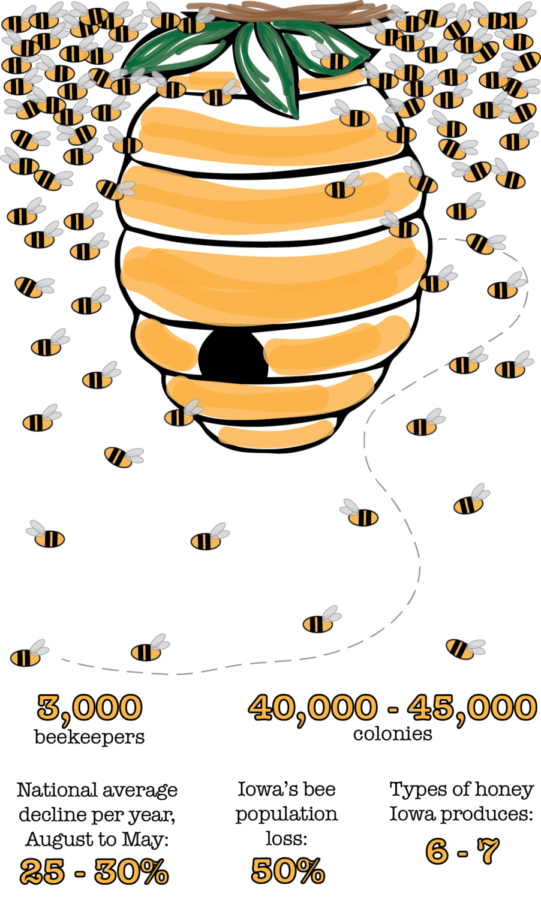Buzzkill: Iowa bee population sees continued decline
Bee population
February 17, 2014
Spring planting affects more than farmers and consumers. The national bee population is declining due to a variety of agricultural processes.
Mary Harris, adjunct assistant professor of natural resource ecology and management, spent last spring collecting samples of honey bee pollen to test for pesticides in and around corn fields during spring planting.
The Corn Dust Research Consortium funded three research teams to research honey bee exposure to dust emitted during treated-seed corn planting.
Harris and the two other participants from Ohio State University and University of Guelph hoped to provide best practices to reduce honey bee exposure for the 2014 planting season.
Harris and her research team worked with farmers in northwestern Iowa to look at foraging resources available for bees to collect pollen during planting.
Every sample was contaminated with neonicotinoids, Harris said. Neonicotinoids are pesticides that are often applied to the surface of corn seeds for protection.
“The [seed] treatment is kind of rough, so when you put all those seeds together in a planter to plant [the seeds], they move around and rub against each other and some of the treatment rubs off,” Harris said. “To keep those seeds moving, manufacturers have produced lubricants … the lubricant becomes contaminated and some of that contaminated dust is exhausted by these planters.”
The problem, Harris said, is the contaminated dust that comes with treating the seeds is exhausted by the planters into the air and can contaminate plants in bloom.
“These insecticides are called neonicotinoids because they’re like nicotine,” Harris said. “It affects the nervous systems of bees and it seems to impair their ability to navigate.”
The study found that bees were relying heavily on pollen from trees and other woody plants. These plants bloom early and were all contaminated, Harris said.
Harris said crops such as soybeans and corn are not good sources of pollen for bees. They rely on the surrounding flora to collect enough pollen. She also said corn pollen is not very nutritious and is a last resort for the bees.
Honey bees are an efficient pollinator and can be moved to areas where crops rely on animal pollination, Harris said. All fruit requires pollination. Harris estimated about one-third of the human diet comes from pollinated sources.
Andrew Joseph, state apiarist with the Department of Agriculture, said there are about 3,000 beekeepers and 40,000 to 45,000 colonies in Iowa.
“The biggest pollination draw is California almonds,” Joseph said. “Almost all of our bees that are kept in Iowa in the summer are in California right now.”
The nation has seen a consistent decline in honey bees. Average losses nationwide are about 25 to 30 percent. Iowa nearly doubles that with 50 percent losses within the last couple of years, Joseph said.
Iowa’s harsh winters are tough for bees, Joseph said. The pesticides and lack of forage nutrition causes stress for the bees, as well.
Joseph said a more diverse landscape would help.
“Crops are pushing out beekeepers from areas,” Joseph said. “[We need to] increase the number of native plants that are attractive to bees.”
Joseph said homeowners can plant flowers to better the area for bee pollination and purchase locally-pollinated foods to support local beekeepers. These foods can be found at farmers markets.
Harris suggested farmers can help by only using the amount of seed treatment that is necessary. Following label recommendations on how to clean equipment can also help.
Farmers can also stay on top of new lubricants that are being tested, Harris said. She suggested looking into putting shields on the equipment so the dust does not get exhausted into the air but instead into the soil.
Harris also suggested that seed suppliers only put the amount of pesticide coating necessary on seeds.







